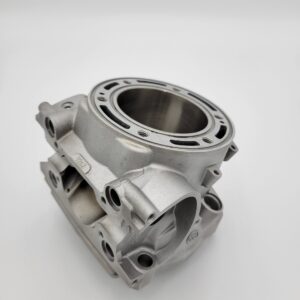Cylinder Repair
A lot of our customers want to know what the steps are in our repair process. (Click here to go to a photo gallery)
The first thing we need to do is to give the cylinder a reference number and log it into our computer system. That makes it possible for us to keep track of where a cylinder is and what we need to do with it next. We also write the same number on any pistons or studs etc so that we can keep track of them too.
Most cylinders that come to us have had a hard, dirty life.
Before we start any serious work on a cylinder, we must clean it thoroughly so that we can REALLY inspect it for damage. We use a variety of cleaners and bead blasting techniques to clean cylinders.
If cylinders come in for repair with any studs, power-valves, dowels etc, they must be removed (or masked) before the cylinder can be stripped. Any parts that are removed are identified with the cylinder number and forwarded to the Shipping Department so that we can include them with the cylinder when it is despatched.
Once the cylinders are cleaned and all the non-aluminium parts etc have been removed or masked, we must remove the old coating. This is normally done by immersion in an acid solution specially selected to avoid damaging the aluminium itself.
After the cylinders are stripped, they must be sorted to go to the correct next operation. The three common choices are:
‘ Send for welding
‘ Send for boring
‘ Send for honing
If a cylinder is cracked, scored or damaged any other way, we can usually repair it by welding and re-machining. The welding process adds aluminium to the damage and builds up any scores. After welding, cylinders must be bored, honed to pre-plate size and the ports must be reshaped and chamfered before plating.
Before we plate a cylinder, we want it to be a specific diameter. The boring operations are not accurate enough for this task, so we treat those as ‘roughing’ processes and we hone the cylinders to our required pre-plate size. After the honing operation, the cylinders will be very oily. Oil is never allowed near the plating chemicals, and so the cylinders must be thoroughly cleaned before plating. We use a combination of solvents and detergents to clean all traces of oil from the part.
Now that the bores have been made straight, round and the right size, we can apply our new electroplated coating. The cylinders are treated in a variety of chemicals to condition the surface before having anodes installed and connected, then the plating process is started. The plating time and current are calculated by computer and, after the time has passed, the cylinders are rinsed, dried and bead blasted to really clean them up and make them look like new again.
Once plated and cleaned on the outside, cylinders face a multi-stage honing process. ‘Pre-honing’ comes first and the main purpose of this operation is remove the extra plating build-up that occurs at port edges etc as a normal part of the electroplating operation. This helps to protect the shape of our very expensive diamond honing tools so that they keep producing accurate bores for as long as possible without unnecessary maintenance. “Rough honing’ is maybe a misleading name for the second stage. In our honing process, we use three progressively finer grades of diamond abrasives. Our “roughing diamonds” remove material quickly but leave a surface finish that is too coarse to be used in an engine cylinder. This stage still produces straight, round bores but we stop cutting a little before we reach our intended finished size. After the bore is ‘rough honed’, the cylinder goes to a chamfering station where all port-edges are ground by hand, and then the ‘head-face’ is checked for flatness on a surface plate. This work may leave small burrs that could damage an engine if they aren’t removed. The small burrs that might be around the ports after the chamfering operations are removed during finish honing. This step also produces the correct surface finish and the precise bore sizing.
Once the cylinder has been cleaned, we must next inspect it visually to confirm that everything we have done is to the correct standard. If everything is ok, it goes to the Shipping Department where we carry out a final check that the correct work has been done, that it’s to the correct standard, that any pistons, studs etc are being returned with the cylinder, and that the completed package is well protected against damage during delivery.
| Weight | N/A |
|---|---|
| Scope of Repair Work | Bore Out & Replate, Rebuild Skirt & Replate, Repair & Replate, Repair Detonation & Replate, Replate |
Related products
-
Cylinder
150 Cylinder Repair & Rebuild Bundle
-
Cylinder
300 Cylinder Repair & Rebuild Bundle
-
Cylinder
250 Cylinder Rebuild Bundle




